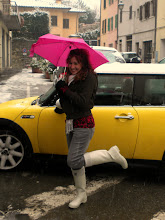One of the most interesting aspects of studying abroad in Europe is how easy it is to serendipitously meet individuals from other countries. For instance, while walking through the Pantheon in Rome I heard people speaking Italian, French, English, Spanish and another language that I could not identify. It’s incredible that the culture is significantly varied. I saw this diversity again while looking for the train back from Rome, when Kelsey, Kim and I met a French woman. We ended up sitting in her compartment and I talked with her for nearly the whole ride. I have taken French since 6th grade so I was more than excited to be able to communicate with someone from France. From our conversation, I learned her name is Julie and she is twenty-eight years old. She lives in Italy now and she travels on weekends to check up on her family. Her grandmother lives in Rome with her brother, who is a priest. Her mother is still in France and Julie wants to visit her more often. In Italian class, I frequently combine French and Italian; this was the most ideal situation for me because Julie’s primary language was French but from living in Italy she has picked up a little Italian. Additionally, she spoke hardly any English but I was still able to communicate with her. Having a full conversation in another language made me feel very accomplished and I really enjoyed this chance encounter and I hope to be able to meet more people on our next adventure.
An adventure I forgot to mention in my last blog was a trip to Deruta. This afternoon excursion was two weeks ago. We ate paper bag lunches on the bus that consisted of four different sandwiches, fruit, water and juice; Margarita’s meals are always exceedingly satisfying. After a short bus ride of about ninety five minutes, the first stop was the Maioliche Originali Deruta. This is a family owned factory that produces a variety of original ceramic pottery for sale. The pieces range from everyday use items such as plates, cups, salad tongs, etc. to elaborate and large works of art. I looked at each item with appreciation, knowing that it was handmade and individually painted. After looking around the showroom, we had the opportunity to see how the ceramic process was begun and completed. We watched as one of the workers “threw” five different pieces on the potter’s wheel in less than ten minutes; it was unbelievable. He certainly made it look easy; I took a ceramics class last year and I personally know how difficult throwing pots on potter’s wheel can be, especially when trying to make each piece a consistent size. The potter told us how he can make close to two hundred pieces a day; he is undeniably talented. After our visit to the factory, we went to a ceramic museum. This museum was designed like a maze; it was not just a straight walk, there were a lot of twists and turns getting to each of the different rooms. This made for a very unique experience because I wasn’t able to predict what was coming next. The contents of the rooms ranged from older broken pieces of ceramics to more modern colorful pieces. After the museum we were given the opportunity to walk around the town. I took a few pictures in the park then ventured on in hopes of finding a ceramic piece for myself. The town comprised of various ceramic shops so there was a lot to choose from. Dr. Webb, Bekah, Dr. Bailey (art history teacher) and Megan accompanied me to one of the side streets where we found a smaller ceramic shop. We looked around and I purchased a pink ceramic jewelry holder that was made in the 1950s; it is perfect for me: pink and an antique!
This weekend’s excursion was to Assisi. In my art history class, we learned about St. Francis of Assisi and this knowledge provided the foundation for the trip. St. Francis was very humble person who loved to talk to animals, especially birds. The basilica in Assisi contained twenty seven frescoes of Saint Francis’ life by the artist Giotto. The “Serman to the birds” was a fresco that really stood out to me. The fresco is very simple with a gray background; the foreground is Saint Francis caring after the birds; this is a large contributing fresco to his life because the communication with the birds is what St. Francis was known for. Later I came to find out that this fresco is actually one of the most famous and most often reproduced pieces of the Giotto series. In addition to all the frescoes, the church had two levels and the lower level contained the tomb of St. Francis. Whenever I went to visit the tomb, the entire room was nearly filled with people sitting and praying. St. Francis was a very famous saint who still has a great amount of respect today. After touring the basilica, the group went and ate lunch then headed back to Sansepolcro. Due to the thunderstorm that appeared to be coming, our hike was canceled. Instead we went to one of Saint Francis’ favorite sites; Castello di Montauto was very close to Sansepolcro and nestled on the top of a mountain. All the surrounded area was covered trees, it was very peaceful. I understand why Saint Francis enjoyed being there; the whole atmosphere was very serene. It was interesting to see the bed where Saint Francis used to sleep. It didn’t even look like a bed, but rather a hole in the wall made of rocks. Saint Francis was certainly a modest man who wanted to be as natural as possible; he didn’t support living a life of luxury.

No comments:
Post a Comment